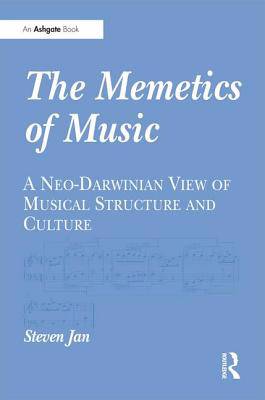
Je cadeautjes zeker op tijd in huis hebben voor de feestdagen? Kom langs in onze winkels en vind het perfecte geschenk!
- Afhalen na 1 uur in een winkel met voorraad
- Gratis thuislevering in België vanaf € 30
- Ruim aanbod met 7 miljoen producten
Je cadeautjes zeker op tijd in huis hebben voor de feestdagen? Kom langs in onze winkels en vind het perfecte geschenk!
- Afhalen na 1 uur in een winkel met voorraad
- Gratis thuislevering in België vanaf € 30
- Ruim aanbod met 7 miljoen producten
Zoeken
The Memetics of Music
A Neo-Darwinian View of Musical Structure and Culture
Steven Jan
Hardcover | Engels
€ 305,45
+ 610 punten
Uitvoering
Omschrijving
Richard Dawkins's formulation of the meme concept in his 1976 classic The Selfish Gene has inspired three decades of work in what many see as the burgeoning science of memetics. Its underpinning theory proposes that human culture is composed of a multitude of particulate units, memes, which are analogous to the genes of biological transmission. These cultural replicators are transmitted by imitation between members of a community and are subject to mutational-evolutionary pressures over time. Despite Dawkins and several others using music in their exemplifications of what might constitute a meme, these formulations have generally been quite rudimentary, even naïve. This study is the first musicologically-orientated attempt systematically to apply the theory of memetics to music. In contrast to the two points of view normally adopted in music theory and analysis - namely those of the listener and the composer - the purpose of this book is to argue for a distinct and illuminating third perspective. This point of view is metaphorical and anthropomorphic, and the metaphor is challenging and controversial, but the way of thinking adopted has its basis in well-founded scientific principles and it is capable of generating insights not available from the first two standpoints. The perspective is that of the (selfish) replicated musical pattern itself, and adopting it is central to memetics. The approach taken is both theoretical and analytical. Starting with a discussion of evolutionary thinking within musicology, Jan goes on to cover the theoretical aspects of the memetics of music, ranging from quite abstract philosophical speculation to detailed consideration of what actually constitutes a meme in music. In doing so, Jan draws upon several approaches current in music theory, including Schenkerism and Narmour's implication-realization model. To demonstrate the practical utility of the memetic perspective, Chapter 6 applies it analytically, tracing the transmission o
Specificaties
Betrokkenen
- Auteur(s):
- Uitgeverij:
Inhoud
- Aantal bladzijden:
- 294
- Taal:
- Engels
Eigenschappen
- Productcode (EAN):
- 9780754655947
- Verschijningsdatum:
- 28/08/2007
- Uitvoering:
- Hardcover
- Formaat:
- Genaaid
- Afmetingen:
- 156 mm x 234 mm
- Gewicht:
- 589 g

Alleen bij Standaard Boekhandel
+ 610 punten op je klantenkaart van Standaard Boekhandel
Beoordelingen
We publiceren alleen reviews die voldoen aan de voorwaarden voor reviews. Bekijk onze voorwaarden voor reviews.









